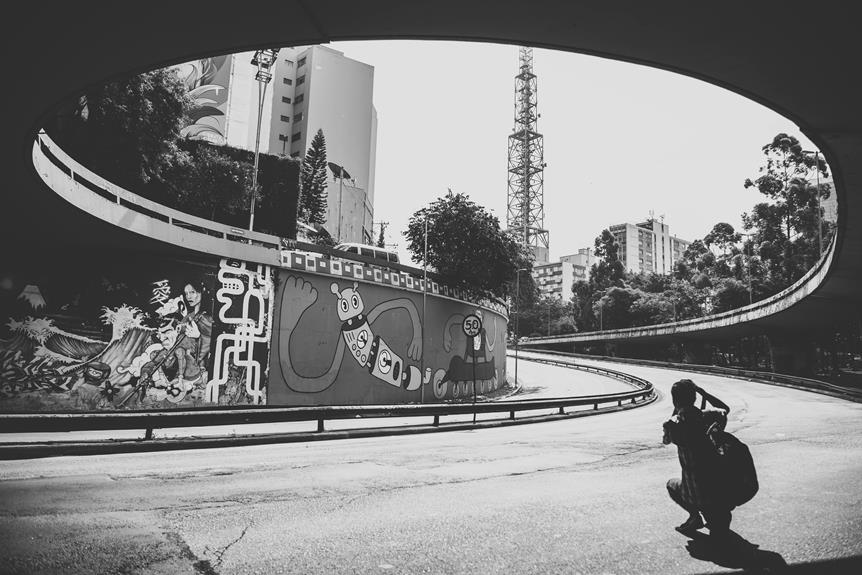You'll appreciate Art Deco paintings for their vibrant fusion of geometric forms and bold colors, celebrating modernity from the 1920s and 1930s. This era, born from post-World War I optimism, embraced luxury, social progress, and the machine age. Pioneers like Tamara de Lempicka and A.M. Cassandre crafted stylized figures and dynamic graphic designs respectively, pushing Art Deco aesthetics. Iconic works like Lempicka's 'Autoportrait' or Cassandre's 'Nord Express' showcase their mastery of form and color. Art Deco's legacy, with its opulent yet streamlined design, continues to influence contemporary art and design, promising deeper insights into this fascinating movement.
Key Points
- Art Deco paintings often feature clean, geometric forms and bold, vibrant colors.
- Notable Art Deco artists include Tamara de Lempicka, known for her stylized, sensual figures.
- Art Deco paintings reflect optimism, technological progress, and social advancement of the 1920s and 1930s.
- Iconic Art Deco artworks include Tamara de Lempicka's 'Autoportrait' and A.M. Cassandre's 'Nord Express'.
- The Art Deco movement integrates streamlined shapes and symmetrical patterns, celebrating luxury and modernity.
Origins of Art Deco
Art Deco, rooted in the early 20th century, emerged as a sophisticated design style in the 1920s and 1930s, shaped by the post-World War I optimism and a fascination with technological advancements. This era celebrated luxury, social progress, and the machine age, reflecting a world keen to embrace modernity.
You'll notice Art Deco's reach across various artistic disciplines—graphic art, fashion, jewelry, sculpture, and architecture—each showcasing clean lines, bold colors, and geometric forms. This movement wasn't just about aesthetics; it was a profound cultural shift toward celebrating innovation and elegance.
Art Deco's legacy transcends time, continuously influencing contemporary design, embodying a hopeful historical moment that emphasizes glamour and sophistication.
Key Characteristics
Often celebrated for their elegance and sophistication, Art Deco paintings are distinguished by their clean, geometric forms and bold, vibrant colors that encapsulate the essence of modernity and luxury. This style thrived in the post-World War I era, reflecting an optimistic belief in technological progress and social advancement.
You'll notice how these paintings often integrate streamlined shapes and symmetrical patterns, embodying the machine age's influence. Additionally, the use of rich, contrasting colors underscores the glamour and opulence of the time.
Art Deco's cross-disciplinary impact is evident in its shared aesthetics with graphic art, fashion, and architecture. These paintings don't just depict scenes; they celebrate capitalism and progress, leaving an indelible mark on the art world.
Influential Artists
Building on the defining characteristics of Art Deco, influential artists like Tamara de Lempicka and A.M. Cassandre pushed the boundaries of this aesthetic, each contributing uniquely to its legacy through their innovative techniques and iconic works. De Lempicka's stylized, sensual figures, exemplified in 'Autoportrait (Tamara in a Green Bugatti)', blend geometric precision with classical portraiture. Cassandre's graphic design prowess is evident in the Nord Express poster, which utilizes bold colors and geometric shapes to capture the era's dynamism.
| Artist | Contribution |
|---|---|
| Tamara de Lempicka | Stylized, sensual figures |
| A.M. Cassandre | Bold, geometric graphic designs |
| Georges Lepape | Fashion illustrations |
| René Lalique | Innovative glass and jewelry designs |
These artists collectively encapsulate the spirit of Art Deco, merging elegance with modernity.
Iconic Artworks
Frequently celebrated for their intricate design and striking visual impact, iconic Art Deco artworks like Tamara de Lempicka's 'Autoportrait' and A.M. Cassandre's 'Nord Express' epitomize the era's fusion of bold geometric forms, vivid colors, and elegant stylization.
De Lempicka's 'Autoportrait' captures the sleek elegance and modernity of the 1920s, with its streamlined forms and sophisticated palette. Cassandre's 'Nord Express' poster harnesses dynamic line work and simplified shapes to symbolize industrial progress.
Meanwhile, René Lalique's 'Victoire' and Léon Bakst's 'Costume for the Firebird' showcase intricate craftsmanship and rich decorative elements. These works, with their meticulous composition and ornamental flair, illustrate how Art Deco melded artistic innovation with a celebration of contemporary life.
Art Deco's Legacy
Art Deco's enduring legacy, characterized by its synthesis of opulence and technological optimism, continues to shape contemporary design and aesthetics across multiple artistic disciplines.
Rooted in post-World War I glamour and luxury, Art Deco celebrated the machine age, social progress, and capitalism. You can see its influence in modern graphic art, set design, fashion, jewelry, sculpture, and architecture.
Today's creators capture the historical movement's sophistication in their works, blending sleek lines, geometric patterns, and rich materials.
Art Deco's celebration of technological advancements and social change still resonates, inspiring designers to merge historical elegance with contemporary innovation, ensuring the movement's relevance and impact in our modern era.
Frequently Asked Questions
What Makes a Painting Art Deco?
You'd identify an Art Deco painting by its geometric shapes, bold colors, and streamlined forms. It reflects post-World War I luxury, modernity, and technological progress, often featuring stylized, sensual figures and a blend of Cubist influences.
What Are 4 Features of Art Deco?
You'd identify four Art Deco features: geometric shapes, bold colors, clean lines, and stylized figures. This blend mirrors post-World War I optimism, technological progress, and luxury, encapsulating the era's artistic, social, and industrial advancements.
What Is the Most Famous Art Deco Piece?
You'll find Tamara de Lempicka's 'Autoportrait (Tamara in a Green Bugatti)' widely regarded as the most famous piece. Its dynamic composition, luxurious subject matter, and innovative use of chiaroscuro epitomize Art Deco's opulence and modernity.
What Are the Three Types of Art Deco?
You've got three types of Art Deco: Zigzag Moderne with its geometric shapes, Streamline Moderne featuring aerodynamic curves, and Classical Moderne combining traditional elements with modern flair. Each reflects the era's tech, luxury, and modernity fascination.
Conclusion
You've explored the origins, key characteristics, and influential artists of Art Deco, unveiling a rich tapestry of innovation and elegance.
By examining iconic artworks, you've witnessed how this movement blends modernism with craftsmanship.
Art Deco's legacy endures, shaping contemporary design and architecture.
Understanding its historical context and technical nuances enhances your appreciation, showcasing its enduring impact on visual culture.
Art Deco isn't just a style; it's a lasting proof of artistic ingenuity and cultural evolution.

